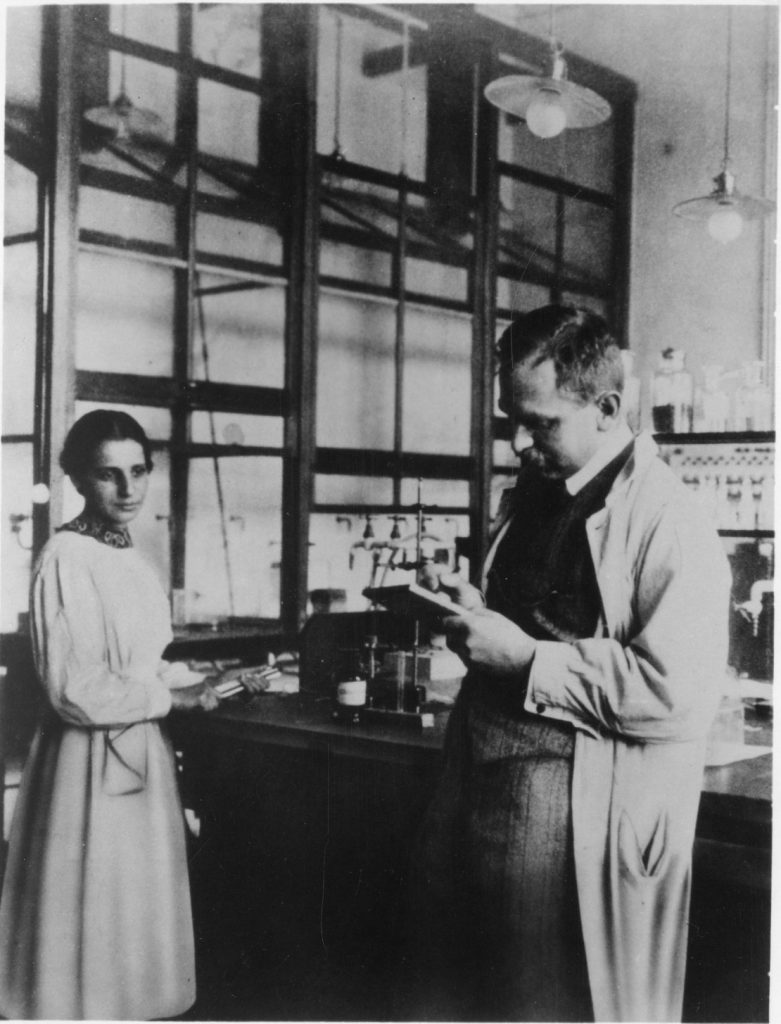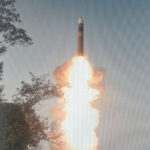Thorium power has a protactinium problem
By Eva C. Uribe | August 6, 2018

In 1980, the International Atomic Energy Agency (IAEA) observed that protactinium, a chemical element generated in thorium reactors, could be separated and allowed to decay to isotopically pure uranium 233—suitable material for making nuclear weapons. The IAEA report, titled “Advanced Fuel Cycle and Reactor Concepts,” concluded that the proliferation resistance of thorium fuel cycles “would be equivalent to” the uranium/plutonium fuel cycles of conventional civilian nuclear reactors, assuming both included spent fuel reprocessing to isolate fissile material.
Decades later, the story changed. “Th[orium]-based fuels and fuel cycles have intrinsic proliferation resistance,” according to the IAEA in 2005. Mainstream media have repeated this view ever since, often without caveat. Several scholars have recognized the inherent proliferation risk of protactinium separations in the thorium fuel cycle, but the perception that thorium reactors cannot be used to make weapons persists. While technology has advanced, the fundamental radiochemistry that governs nuclear fuel reprocessing remains unchanged. Thus, this shift in perspective is puzzling and reflects a failure to recognize the importance of protactinium radiochemistry in thorium fuel cycles.
Protactinium turns 100. The importance of protactinium chemistry for obtaining highly attractive fissile material from thorium has been recognized since the 1940s. However, the story really begins 100 years ago during the earliest research on natural radioactivity. In 1918, Austrian-Swedish physicist Lise Meitner and German chemist Otto Hahn were on a quest to discover the long-lived isotope of “eka-tantalum” predicted to lie between thorium and uranium in the periodic table. The isotope they sought would decay to actinium, which was always found with uranium but was known to be the parent of an unknown natural radioactive decay chain distinct from that of uranium 238, the most common isotope of uranium found in nature.
Meitner and Hahn discovered that treating pitchblende with nitric acid yielded an insoluble fraction of silica that associated with tantalum and eka-tantalum. After many years, they purified enough eka-tantalum for identification and measured its properties. As discoverers of eka-tantalum’s longest-lived isotope, Meitner and Hahn named this new element protactinium. They had isolated protactinium 231, a member of the uranium 235 decay chain. In 1938, they discovered that protactinium 233 could be produced by neutron irradiation of thorium 232, the most abundant isotope in naturally occurring thorium.
For the next several decades, protactinium was shrouded in “mystery and witchcraft” due to its scarcity in nature and its perplexing chemical properties. We now know that protactinium’s peculiar chemistry is due to its position in the periodic table, which lends the element vastly different chemical properties than its neighbors. Protactinium behaves so differently from thorium and uranium that, under many conditions, their separation is inevitable.
Scientists did not investigate the macroscopic chemistry of protactinium until the Manhattan Project. In 1942, Glenn T. Seaborg, John W. Gofman, and R. W. Stoughton discovered uranium 233 and observed its propensity to fission. Compared with naturally occurring uranium 235, uranium 233 has a lower critical mass, which means that less material can be used to build a weapon. And compared with weapons-grade plutonium 239, uranium 233 has a much lower spontaneous fission rate, enabling simpler weapons that are more easily constructed. A 1951 report by the Manhattan Project Technical Section describes extensive efforts devoted to the production of uranium 233 via neutron irradiation of thorium 232. Because the initial thorium feed material was often contaminated with natural uranium 238, the scientists obtained pure uranium 233 by using a variety of methods for separating the intermediate protactinium 233.
By this time, advances in technology and projections of uranium shortages stimulated interest in developing a breeder reactor, which produces more fissile material than it consumes. In the late 1960s, a team at Oak Ridge National Laboratory designed a Molten Salt Breeder Reactor fueled by thorium and uranium dissolved in fluoride salts, but it could only breed uranium 233 by continuously removing impurities—including protactinium 233—from the reactor core. To improve breeding ratios, the researchers investigated methods for removing protactinium from the molten fluoride salts.
In 1977, President Jimmy Carter banned commercial reprocessing of spent nuclear fuel, citing concerns with the proliferation of technology that could be used to make nuclear weapons. And with the high startup costs of developing new reactors, there would be no place for the Molten Salt Breeder Reactor in the energy market. With the end of research on thorium reactors came the end of ambitious research on protactinium separations. Over time, the role of protactinium in obtaining weaponizable uranium 233 from thorium was largely forgotten or dismissed by the thorium community.
Thorium reactors born again. Fast forward to 2018. Several nations have explored thorium power for their nuclear energy portfolios. Foremost among these is India. Plagued by perennial uranium shortages, but possessing abundant thorium resources, India is highly motivated to develop thorium reactors that can breed uranium 233. India now operates the only reactor fueled by uranium 233, the Kalpakkam Mini reactor (better known as KAMINI).
Thorium reactors have other potential advantages. They could produce fewer long-lived radioactive isotopes than conventional nuclear reactors, simplifying the disposal of nuclear waste. Molten salt reactors offer potential improvements in reactor safety. Additionally, there is the persistent perception that thorium reactors are intrinsically proliferation-resistant.
The uranium 233 produced in thorium reactors is contaminated with uranium 232, which is produced through several different neutron absorption pathways. Uranium 232 has a half-life of 68.9 years, and its daughter radionuclides emit intense, highly penetrating gamma rays that make the material difficult to handle. A person standing 0.5 meters from 5 kilograms of uranium 233 containing 500 parts per million of uranium 232, one year after it has been separated from the daughters of uranium 232, would receive a dose that exceeds the annual regulatory limits for radiological workers in less than an hour. Therefore, uranium 233 generated in thorium reactors is “self-protected,” as long as uranium 232 levels are high enough. However, the extent to which uranium 232 provides adequate protection against diversion of uranium 233 is debatable. Uranium 232 does not compromise the favorable fissile material properties of uranium 233, which is categorized as “highly attractive” even in the presence of high levels of uranium 232. Uranium 233 becomes even more attractive if uranium 232 can be decreased or eliminated altogether. This is where the chemistry of protactinium becomes important.
Protactinium in the thorium fuel cycle. There are three isotopes of protactinium produced when thorium 232 is irradiated. Protactinium 231, 232, and 233 are produced either through thermal or fast neutron absorption reactions with various thorium, protactinium, and uranium isotopes. Protactinium 231, 232, and 233 are intermediates in the reactions that eventually form uranium 232 and uranium 233. Protactinium 232 decays to uranium 232 with a half-life of 1.3 days. Protactinium 233 decays to uranium 233 with a half-life of 27 days. Protactinium 231 is a special case: It does not directly decay to uranium, but in the presence of neutrons it can absorb a neutron and become protactinium 232.
Neutron absorption reactions only occur in the presence of a neutron flux, inside or immediately surrounding the reactor core. Radioactive decay occurs whether or not neutrons are present. For irradiated thorium, the real concern lies in separating protactinium from uranium, which may already have significant levels of uranium 232. Production of protactinium 232 ceases as soon as protactinium is removed from the neutron flux, but protactinium 232 and 233 continue to decay to uranium 232 and 233, respectively.
The half-lives of the protactinium isotopes work in the favor of potential proliferators. Because protactinium 232 decays faster than protactinium 233, the isotopic purity of protactinium 233 increases as time passes. If it is separated from its uranium decay products a second time, this protactinium will decay to equally pure uranium 233 over the next few months. With careful attention to the relevant radiochemistry, separation of protactinium from the uranium in spent thorium fuel has the potential to generate uranium 233 with very low concentrations of uranium 232—a product suitable for making nuclear weapons.
Scenarios for proliferation. Although thorium is commonly associated with molten salt reactors, it can be used in any reactor. Several types of fuel cycles enable feasible, rapid reprocessing to extract protactinium. One is aqueous reprocessing of thorium oxide “blankets” irradiated outside the core of a heavy water reactor. Many heavy water reactors include on-power fueling, which means that irradiated thorium can be removed quickly and often, without shutting the reactor down. As very little fission would occur in the blanket material, its radioactivity would be lower than that of spent fuel from the core, and it could be reprocessed immediately.
Myriad possibilities exist for the aqueous separation of protactinium from thorium and uranium oxides, including the commonly proposed thorium uranium extraction (THOREX) process. Alternatively, once dissolved in acid, protactinium can simply be adsorbed onto glass or silica beads, exploiting the same chemical mechanism used by Meitner and Hahn to isolate protactinium from natural uranium a century ago.
Another scenario is continuous reprocessing of molten salt fuel to remove protactinium and uranium from thorium. Researchers at Oak Ridge explored the feasibility of online protactinium removal in the Molten Salt Breeder Reactor program. Uranium can then be separated from the protactinium in a second step.
Sensible safeguards. Protactinium separations provide a pathway for obtaining highly attractive weapons-grade uranium 233 from thorium fuel cycles. The difficulties of safeguarding commercial spent fuel reprocessing are significant for any type of fuel cycle, and thorium is no exception. Reprocessing creates unique safeguard challenges, particularly in India, which is not a member of the Nuclear Non-Proliferation Treaty.
There is little to be gained by calling thorium fuel cycles intrinsically proliferation-resistant. The best way to realize nuclear power from thorium fuel cycles is to acknowledge their unique proliferation vulnerabilities, and to adequately safeguard them against theft and misuse.
Together, we make the world safer.
The Bulletin elevates expert voices above the noise. But as an independent nonprofit organization, our operations depend on the support of readers like you. Help us continue to deliver quality journalism that holds leaders accountable. Your support of our work at any level is important. In return, we promise our coverage will be understandable, influential, vigilant, solution-oriented, and fair-minded. Together we can make a difference.
Keywords: India, Thorium, breeder reactor, molten salt, proliferation, protactinium, reprocessing, uranium
Topics: Nuclear Energy, Nuclear Risk, Nuclear Weapons, Voices of Tomorrow
















U233 requires a much larger form factor for a bomb.
I agree with the text above. This is why we need thoriumsalt.net. – by the way. You can always roast U238 or Th232 and get weapon material like they did at Hanford. You can even do this in a fusion reactor. Thus we always need to know what goes in and what comes out of any machine with high neutron flux and share this as open data. Else I don’t think you should be trusted with such a machine.
The key logical flaw in this article is that it utilizes in its examples strawman reactor designs cherry picked for their proliferation vulnerability. Molten Salt reactors are a design class that encompasses bot vulnerable and hardened designs. It would be far more illustrative had the author started with a proliferation hardened design with “intrinsic” passive physics based systems that greatly impede the actual real world logistics of a would be breakout attempt. I’d maintain that compared to clandestine centrifuge seperation attempts that it is logistrically prohibitive for the hypothetical adversary to clandestinely: – take an ISOBREEDING Thorium MSR design that… Read more »
You’re using straw man arguments too — trying to make it sound difficult and ignoring very simple ways that terrorists or rogue nations could very easily modify any Thorium MSR to produce U-233 for weapons, or create and detonate a U-233 explosion in the MSR building itself. One of the core tenants of anti-proliferation is “the worst case is the case we must assume will happen”. If you’re going to argue about proliferation, then you need to follow this rule. The burden of proof is on YOU to prove that a worst case terrorist scenario is 100% impossible. Even 1%… Read more »
“Solid fuel reactors already fulfill this requirement. You must too.” Really, I would love to see that proof for solid fuel because what you are doing is trying to set up a competition between a physically possible system and the non-existent imaginary utopia in your head. That 100% standard you mention does not exist for any system. Nothing is 100% safe and nothing is 100% certain; not to mention the folly of asking someone to prove a negative. You might as well be asking me to prove that an invisible, intangible dragon does not live in your garage (https://www.youtube.com/watch?v=jJRy3Kl_z5E). Anyone… Read more »
If a rogue nation has the ability to construct an MSR, they have the ability to refine fuels. You still have the problem of needing neutron bombardment in order to produce the transuranics with the decay chains you need and an MSR just makes this more difficult in that now, not only do you still need to separate your Protactinium from your other elements, and wait for it to decay, you must first extract it from your fuel salt mix. It’s easier to start with solid fuels that are purer. Proliferation in this case, isn’t really a concern. About the… Read more »
Protactinium is not a proliferation problem in a molten salt reactor like ThorCon. It remains In the fuel salt until it decays or absorbs a neutron. It’s not separated for special processing. Adding thorium to the fuel salt significantly improves proliferation resistance because it makes the chemical separation of plutonium (from U-238 neutron absorption) from used fuel salt much more difficult technically and financially.
Protactinium is a fuel, not a problem. Turns into U-233, the worst possible bomb material you can pick. 0.5% of it is U-232, which is not trivial to separate, and decays quickly into elements that will kill you and can be detected so far away that satelites in space could find your bomb factory trivially.
Molten salt thorium reactors’ biggest fatal flaw is that they’re a couple of billion dollars in engineering away from existing. That’s it.
A couple of billion dollars in engineering is trivial (compared to the upside for power generation) if a standard, safe design can be developed.
Ah, the usual cast of Thorium nuts are here to spread disinformation again. Every single method of “hardening” an MSR against U-233 diversion could be turned off with a few twists of a pipe wrench. Every thorium MSR can be used to create pure U-233. U-232 can easily be ignored if you want a simple, primitive bomb. Actually U-233 is one of the simplest bombs to make — a gun barrel bomb with no preignition. It would not be powerful, but you could make it right in the MSR building itself, so that even a dud ignition would vaporize hundreds… Read more »
If it’s so easy, then it should be no issue for you to go into detail of the threat case explaining just how easy it is to defeat a hardened system. Oh and to be fair, please also present it as a differential comparison versus your favored physically feasible energy solution and not some vague made-up utopia in your head.
I keep thinking it has little to do with proliferation or non-proliferatiion. Its all about economics and jobs and who gets them. The US passed the Nuclear source materials act, and an arguable result was that the value add chain for rare earth materials, worth trillions of dollars, is largely absent from the US economy and resides mostly in China, and the world did not benefit from source material control as a result. If the MSR is really the better energy solution for commercial heat and electricity, the current path will give that trillion dollar industry to China as well,… Read more »
If U-233 is such good bomb making material, why has no nuclear power ever made a pure u-233 bomb? I think a simple google search might turn up the answers….
You as well as the author are very intellectually dishonest people. You enough to post partial truths. Though, you know that U233 can be denatured by Uranium 238. Denaturation of fissile materials allows for the process of transforming them into a form that is not suitable for weapons use and can not easily be reversely transformed. Terrestial Energy and/or ThorCon designs can be deployed with denatured designs. As well, after the fuel has been utilized for ~ 4-8 years, then it can be moved to a suitable location to “cool” down in a protected location and the protactinium will beta… Read more »
Eva C. Uribe is a senior member of the technical staff at Sandia National Laboratories. She was a 2016-2017 Stanton Nuclear Security postdoctoral fellow at the Center for International Security and Cooperation at Stanford University, where she investigated fissile material production pathways in the thorium fuel cycle. She received a Ph.D. in chemistry from the University of California, Berkeley in 2016.
Wouldn’t removing U233 from a MSR poison it threatening criticality? I mean the reactor design needs the U233’s extra protons to keep making the thorium into protactinium right? So how are you going to get 233 out of the system without killing it?
Correction extra neutrons.
so part of tom ledbetter’s argument is that the MSR’s are vulnerable to attack and can’t be prevented from vaporizing their fuel if blown up?
In the end, forgive the ignorance, I still didn’t understand which high gammas U-232 should be in the 232-233 uranium mix to make it proliferation resistant, aside from the fact that is somehow risky to separate from neutron flux and storage intermediate produced proactinium
Removal of protactinium is completely unnecessary as it will naturally morph into U233 in the reactor and be consumed. Removal is only necessary for bomb production.
The vulnerability described is a vulnerability for molten salt reactors for which protactinium needs to be extracted on line together with fission fragments.
In Accelerator-driven systems as proposed for instance by Carlo Rubbia at CERN, protactinium does not need to be extracted at all, and is present in the spent fuel at the end of the cycle (5 to 10 years) can be extracted together with the other actinides to be be recycled, without separation of the protactinium. This can be done in the pyro-reprocessing method, developed at Argonne National Lab.